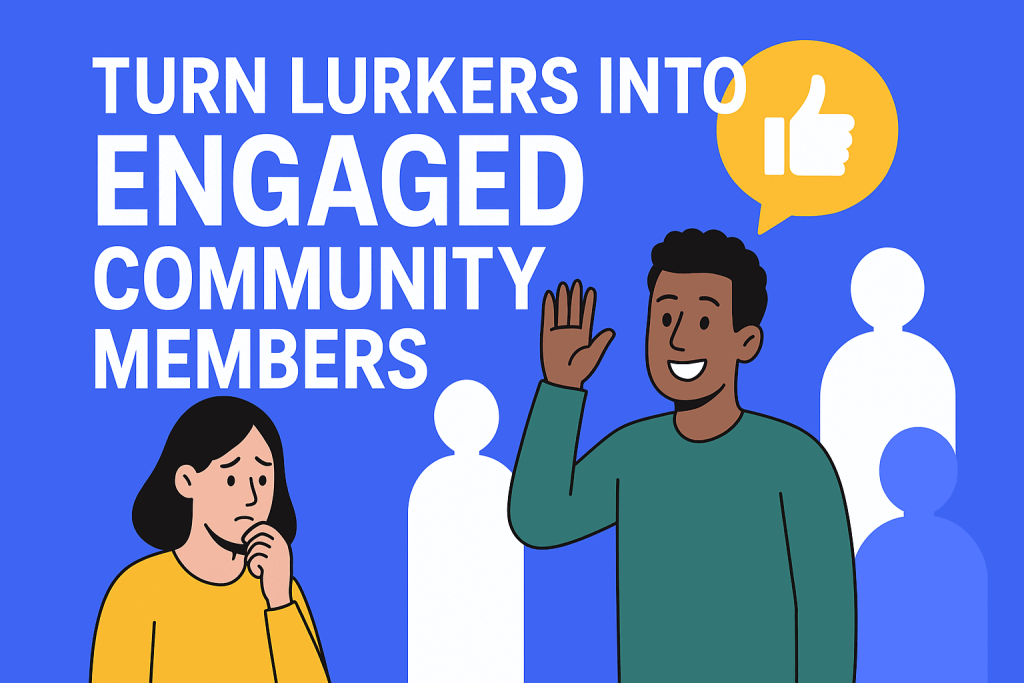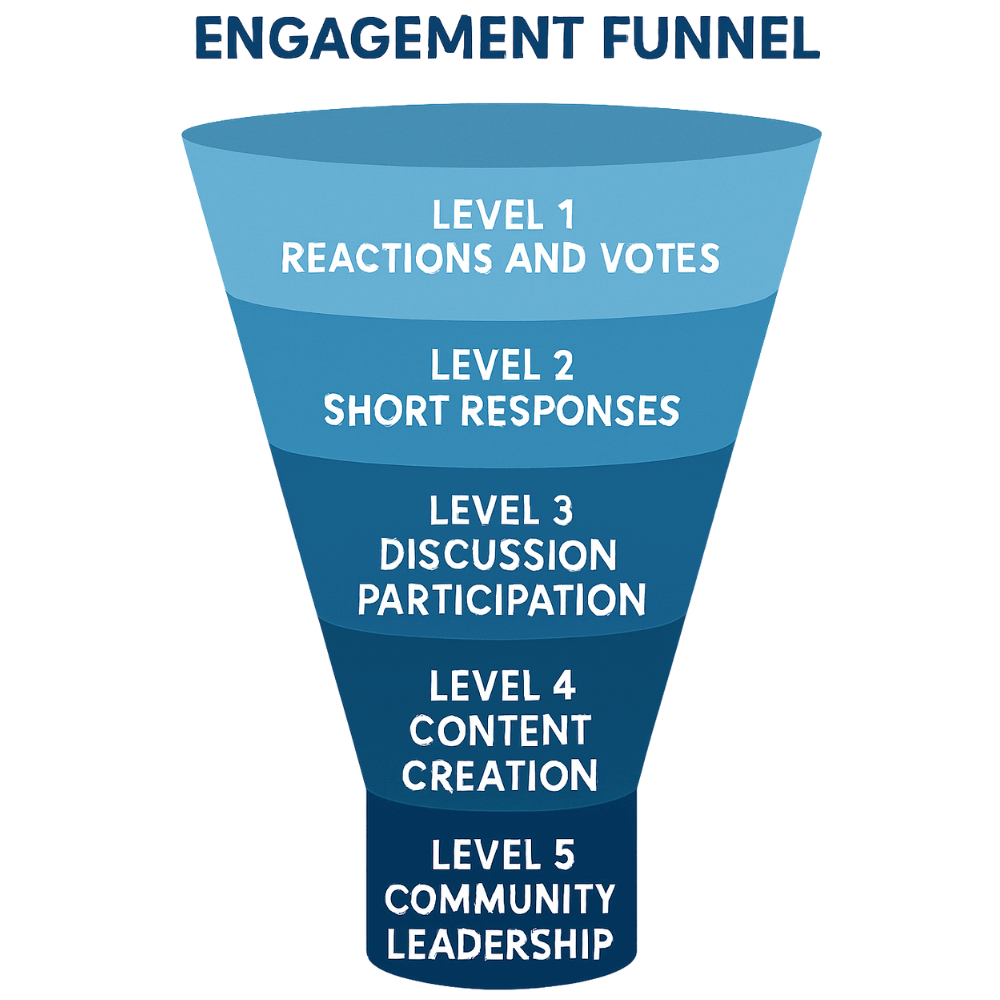Silent scrollers fill every online community. They read posts, watch videos, and consume content without ever hitting “reply” or sharing their thoughts. These passive members—commonly called lurkers—make up 80-90% of most online communities. While they’re engaged consumers, they’re not contributing to the conversations that make communities thrive.
The good news? You can increase community engagement by converting these quiet observers into active participants. Research shows that even small nudges can transform lurkers into valuable contributors who spark discussions, share insights, and help build the vibrant community culture you’re after.
Converting passive members requires understanding why people lurk and implementing targeted strategies that make participation feel natural, rewarding, and safe. Let’s explore proven methods to boost user interaction and create an environment where every member feels motivated to contribute.
Understanding the Psychology Behind Lurking
Most lurkers aren’t disinterested—they’re cautious. New members often feel uncertain about community norms, worry about saying the wrong thing, or simply prefer observing before jumping into conversations.
Online community behavior research reveals several common reasons why people remain passive:
Fear of judgment: Many members worry their contributions won’t be valuable or might face criticism from established community members.
Lack of confidence: New members may feel they don’t know enough about the topic to contribute meaningfully to discussions.
Unclear expectations: When community guidelines or participation expectations aren’t clear, members default to passive consumption rather than risk making mistakes.
Overwhelming volume: Large, active communities can feel intimidating to new members who struggle to find their place in ongoing conversations.
Understanding these barriers helps you design member engagement tactics that address specific concerns and create pathways for comfortable participation.

Create an Effective Onboarding Experience
Strong community onboarding is your first opportunity to encourage participation. Instead of overwhelming new members with information, focus on creating quick wins that build confidence.
Welcome new members personally: Direct messages or mentions help new members feel noticed and valued from day one.
Provide clear participation guidelines: Share simple, actionable examples of how to contribute rather than lengthy rule lists.
Assign buddy systems: Pair newcomers with established members who can answer questions and provide encouragement.
Create beginner-friendly spaces: Designate areas specifically for introductions, basic questions, or first-time contributions where judgment feels lower.
Effective onboarding of community members sets the foundation for long-term engagement by removing barriers and providing clear pathways to participation.
Design Compelling Conversation Starters
Active vs passive community members often differ based on how conversations begin. Lurkers are more likely to respond to specific, approachable prompts than broad, general discussions.
Ask specific questions: Instead of “What do you think about X?”, try “What’s one challenge you faced when starting X?”
Share personal experiences first: When community leaders model vulnerability by sharing their own stories, members feel safer contributing theirs.
Use polls and quick responses: Low-stakes participation options like polls, reactions, or one-word responses help ease members into more substantial contributions.
Create recurring discussion themes: Regular features like “Monday Motivation” or “Friday Wins” give lurkers predictable opportunities to participate.
Creating conversation starters that feel accessible and relevant encourages lurkers to take their first steps toward active participation.
Implement Smart Gamification Strategies
Gamification in communities can motivate participation when implemented thoughtfully. The key is rewarding meaningful contributions rather than just activity volume.
Recognition systems: Highlight valuable contributions through member spotlights, featured posts, or community awards.
Progressive challenges: Create participation milestones that gradually increase in complexity, helping members build confidence over time.
Peer nomination programs: Allow community members to nominate each other for contributions, creating positive peer recognition cycles.
Achievement visibility: Make member accomplishments visible to encourage others while celebrating individual progress.
Effective gamification focuses on community value rather than vanity metrics, ensuring that engagement improvements translate into genuine relationship building.
Leverage Technology and Data Insights
Modern community platforms offer powerful tools to understand and influence engagement patterns. Machine learning for community growth can identify participation opportunities and optimize your strategies.
Analyze engagement patterns: Track when lurkers are most active, which content types generate responses, and what topics spark the most discussion.
Personalize outreach: Use member data to send targeted invitations to discussions that align with their interests or expertise.
Optimize timing: Post content and start conversations when your lurkers are most likely to be online and receptive.
A/B test approaches: Experiment with different conversation starters, onboarding sequences, or engagement tactics to identify what works best for your specific community.
Data-driven community participation strategies help you focus efforts on the most effective tactics for your unique member base.
Build an Engagement Funnel

Think of member participation as a progression rather than an all-or-nothing choice. Your engagement funnel should provide multiple entry points and gradual escalation opportunities.
Level 1: Reactions and votes: Simple, low-risk ways to acknowledge content without creating original contributions.
Level 2: Short responses: Brief comments, answers to direct questions, or sharing quick experiences.
Level 3: Discussion participation: Engaging in back-and-forth conversations with other members.
Level 4: Content creation: Starting new discussions, sharing resources, or creating original posts.
Level 5: Community leadership: Mentoring newcomers, moderating discussions, or organizing community events.
This staged approach respects that not every member will (or should) reach the highest participation levels, while providing clear pathways for those ready to increase their involvement.
Measure Success and Iterate
Tracking the right metrics helps you understand whether your community participation strategies are working. Focus on meaningful engagement rather than vanity numbers.
Participation conversion rates: Monitor what percentage of lurkers make their first contribution each month.
Member retention: Track whether newly active members continue participating over time.
Discussion quality: Measure the depth and value of conversations, not just their frequency.
Member satisfaction: Regular surveys help you understand whether participants feel valued and heard.
Use these insights to refine your approach, celebrating successes while identifying areas for improvement.
Creating Lasting Community Culture Change
Converting lurkers into active participants isn’t a one-time project—it’s an ongoing commitment to creating an environment where every member feels empowered to contribute. Success comes from consistent effort to reduce participation barriers, recognize valuable contributions, and model the inclusive behavior you want to see.
Start by implementing one or two strategies that align best with your community’s current needs and culture. Monitor results carefully, and gradually expand your efforts as you see positive changes in member behavior.
Remember that some lurkers may always prefer passive participation, and that’s perfectly valid. Your goal isn’t to convert every silent member, but to ensure that those who want to participate feel welcomed, supported, and valued when they take that step.
Focus on progress over perfection, celebrate small wins, and maintain patience as you build the thriving, engaged community you envision.





